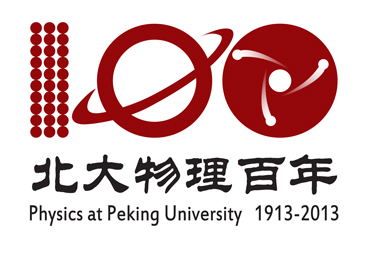 |
School of Physics at Peking University 2013, Volume 8, Number 5 |
|---|
 Location
Location
No. 209, Chengfu Road, Haidian District, Beijing
School of Physics, Peking University, Beijing
http://www.phy.pku.edu.cn
Key Contact
Professor Xin-Cheng Xie
Dean, School of Physics, Peking University
E-mail: xcxie@pku.edu.cn,xincheng.xie@okstate.edu
Overview
Peking University
Peking University has a long and rich history. Founded as the Imperial University of Peking in 1898, it is the first established modern national university of China. In 1912, it was renamed National Peking University. With Tsinghua University and Nankai University in Kunming, it formed the National Southwestern Associated University in 1938. In 1952, after merging with Yenching University, it moved to its present campus and was renamed Peking University.
The main campus of Peking University, known as Yan Yuan(the garden of Yan), is situated in Haidian District in the northwestern part of Beijing, with a total area of 2 743 532 square metres (274 hectares). It is near the Yuanmingyuan Garden and the Summer Palace and is especially renowned for the beauty of its traditional Chinese architecture.
Today, Peking University is frequently placed as one of the best comprehensive universities in China by many national and international rankings. The University consists of 30 colleges and 12 departments. It embraces diverse branches of learning in natural sciences, engineering, medical sciences, management, social sciences and humanities.
The History of the School of Physics
The Wuli Men (Physics Division) was established at Peking University in 1913 and renamed the Department of Physics in 1919. With the reorganization of the Chinese system of higher education in 1952, the new Physics Department of Peking University was created from the merger of the physics departments of Peking University, Tsinghua University and Yenching University. This became the premier center for physics in China. The School of Physics was established in 2001, and includes not only the traditional fields of physics, but also related physical sciences. Today, the School of Physics includes Physics, Astronomy, Atmospheric & Oceanic Sciences, and Nuclear Science & Technology and consists of eleven divisions and seven related research institutes, including the State Key Laboratory for Artificial Microstructure and Mesoscopic Physics and the State Key Laboratory of Nuclear Physics and Technology. Throughout its history, the School of Physics has educated and hosted many prominent physicists, including figures such as Ta-You Wu, C. N. Yang, T. D. Lee, and Kun Huang.
It has been nearly 100 years since Peking University established its Department of Physics. The Department’s founding was not only an announcement of the importance that Peking University placed on the physical sciences, but also a milestone in the development of modern science in China. One hundred years on, the School has made distinguished contributions to the world in both education and academia. As it embarks on its second century, the Peking University School of Physics extends a warm welcome to distinguished scholars and outstanding young students from China and abroad who wish to join its ranks.
The Faculty and Students
Today, the School of Physics has about 280 faculty and staff. It grants Bachelor of Science, Master of Science, and Doctor of Philosophy degrees. Around 200 undergraduate students and more than 200 graduate students are admitted each year by the School of Physics (more than 150 for PhD degrees and 50 for Master degrees). Most undergraduate students pursue advanced studies after finishing their Bachelor degrees, and about one-third of them attend leading international universities for their advanced study. The School of Physics has a tradition of excellent teaching in both graduate and undergraduate courses. Scholars in the School of Physics have published more than one hundred textbooks and monographs since 1991.
Laboratories, Institutes and Centers
Research in the School of Physics is devoted not only to the frontiers of fundamental physics but also to the innovation of advanced technology. The School plays a leading role in planning and executing regional, national, and international scientific research programs. Major research fields include: high energy physics,astrophysics and cosmology, radioactive nuclear physics, high energy-density physics, key technologies for advanced light sources and particle beams, the interaction of particle beams with materials, mesoscopic semiconductor light emission and laser physics, ultra-fast physics, optical properties of artificial microstructures and mesoscopic devices, electro-magnetic properties of mesoscopic functional systems, mesoscopic theory and material computation, high-temperature superconductivity physics and devices, nano-material and devices, near-field optics, quantum materials and quantum manipulation, soft condensed matter physics, biophysics,medical physics and imaging, atmospheric physics and the environment, meteorology and climate change, physical oceanography, and many others. In 2012, Prof. Daniel Chee Tsui, 1988 Nobel Prize Laureate, became a member of the School of Physics and the Daniel Chee Tsui Laboratory at Peking University was established with the School’s support.
Scholars in the School have been awarded three National Prizes and two National Science & Technology Progress Awards in the past five years. During this period, the School has more than 300 on-going and completed research projects, including five national basic research programs (“973” projects), seven national high technology research and development programs (“863” projects) and more than 20 NSFC key projects. Research funding in the School has progressively increased in recent years.
The Peking University School of Physics now has the following divisions and related research institutes:
·Institute of Theoretical Physics
·Institute of Condensed Matter and Material Physics
·Institute of Modern Optics
·Institute of Heavy Ion Physics
·Institute of Plasma Physics and Fusion Study
·Department of Technical Physics
·Department of Astronomy
·Department of Atmospheric and Oceanic Sciences
·Teaching Center for General Physics
·Teaching Center for Experimental Physics
·Electron Microscopy Laboratory
·State Key Laboratory for Artificial Microstructure and Mesoscopic Physics
·State Key Laboratory of Nuclear Physics and Technology
·Beijing Key Laboratory of Medical Physics and Engineering
·Center for High Energy Physics
·International Center for Quantum Materials
·Kavli Institute for Astronomy and Astrophysics
·Institute of Nuclear Science & Technology
International Relations
The School is involved in a wide range of international activities. A number of faculty members serve as committee members in many international scientific organizations and as editors for leading international journals. Peking University participates in many international collaborations, in particular the world’s largest high-energy physics project, LHC-CMS, as well as a number of other projects, such as RIKEN and KEK in Japan, GSI and DESY in Germany, and JLab and ANL in the United States. The School of Physics organizes various international conferences and summer schools as well as seminars.
To celebrate its centennial, the School of Physics created the distinguished lecture series “Centennial Physics Lectures” at Peking University in 2010. The lecture series will be held once each semester. Eminent scholars from around the world will be invited to present lectures on both fundamental and cutting-edge problems in physics, astronomy, and atmospheric and oceanic sciences. We hope that this lecture series will establish a thought-provoking forum, stimulate lively and topical intellectual debates, strengthen global and interdisciplinary collaborations, promote the advancement of physical sciences, and extend the distinguished and innovative scholarly tradition at Peking University.
Seven lectures have now been held by Centennial Physics Lectures:
·Does the everyday world really obey quantum mechanics? - Anthony J. Leggett
·Physics of Nano-Scale Systems: Nanoscience: Towards a New Technology - Johannes G. Bednorz
·The Frontiers of Fundamental Physics - David J. Gross
·The Hydrological Cycle and Global Warming - Isaac M. Held
·Manipulating and Transforming Photons with Nanotechnology: From Photo-Physics to Emerging Technologies - Paras N. Prasad
·Nuclear Mass Limits: Discovery of Super Heavy Elements - Yuri Oganessian
·Photoelectric Effect: A Century of Discovery and Innovation – Zhi-Xun Shen
Facilities and Equipment
There has been rapid improvement in the facilities and equipment for scientific research in recent years, with a total annual expenditure of more than 200 million RMB. This has resulted in a number of flagship instruments, including a seven-femtosecond CE-phase-stabilized laser amplifier system, a molecular beam epitaxy system, a metal-organic chemical vapor deposition system, a focused ion beam workstation, and four electrostatic ion accelerators.